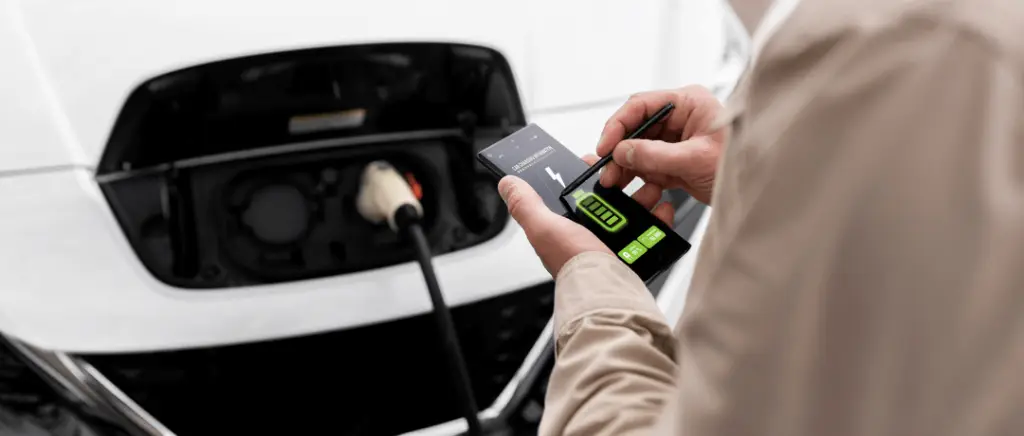Monday to Friday
9am - 12.30pm - 2pm - 7pm
Connected charging point: definition
New technologies are constantly evolving and making their way into charging stations. These include connected charging stations.
Thanks to an internet connection, this type of kiosk is connected to a backend, a management system. What's more, they can be easily controlled remotely via a smartphone. This means that the user or even the manager of the kiosks will have a number of options, such as :
- schedule recharging sessions,
- get real-time information from the terminals and the electric vehicles connected,
- consult the use and consumption of the terminal.
This type of terminal is very useful if you have a fleet of electric vehicles or if you live in detached house.
Connected bollards vs intelligent bollards: what's the difference?
Can you tell the difference between a connected charging point and a smart charging point? These two types of charging point are in fact opposites. Here's why.
Unlike the connected recharging point, the intelligent terminal has much more advanced technologyin other words, it has capabilities for analysis, load optimisation and interaction with other infrastructures, including smart grids or building energy management systems.
The intelligent recharging point will be able to deliver the necessary recharging power according to a number of parameters:
- overall electricity demand,
- the availability of renewable energy,
- the price of electricity,
- how these terminals are used.
The information gathered by this type of charging point will enable users to optimise their charging at a lower cost.
Why should your company have connected recharging points?
As mentioned above, the LOM law (Mobility Orientation Law) is pushing for the electrification of businesses in France. To ensure that electric vehicles are as efficient as possible, this means equipping them with high-performance recharging stations.
Here are some of the advantages of installing connected charging points:
Manage remote charging points
Managing your charging points remotely is a real advantage. With Internet access and an online platform, you can :
- program your terminals For example, you can choose when you want to charge your vehicles, and select the sessions and charging method. And all from a distance,
- real-time information on your terminalsFor example, you can see how long your terminals have been in use or how much energy they have consumed,
- control several terminals from the same interface including for multisites.
Save time
Using connected recharging points is a real time-saver. With easily programmable remote terminalsYou can schedule recharging sessions or make a recharging point available for use or not. What's more, it's no longer necessary to monitor the charging points manually.
The connected terminal can save your users time, as they will be completely autonomous in their use, saving you time as a company.
Generate new income
In general terms, a charging point installed in a business generates additional income. You can maximise revenue by charging users for the electricity they consume at 3 different rates (free, partial or full) or by offering recharging services to the public.
What's more, by introducing an at-cost or premium tariff, you can achieve a faster return on investment. This can help offset the cost of installing and maintaining therecharging infrastructure.
Complying with the LOM law
Connected charging points also comply with the LOM law (Mobility Orientation Law). This law was created to simplify mobility for the French, while taking environmental issues into account, in particular by achieving a "green" mobility policy. carbon neutrality by 2050 and a 60 % reduction in CO2 emissions by 2030.
By opting for a recharging point, you are anticipating future standards and giving your company a good image with your employees and any outsiders who use your points (if they are open to the public).
What's more, when it comes to electrifying your company, there are obligations to be taken into account for new and existing buildings.
- For the new or renovated buildings mainly for industrial or tertiary use, you are required to pre-equip part of their car parks with charging points for your employees' electric or plug-in hybrid vehicles,
- For the existing buildingsIn 2015, the pre-equipment obligations were established. Existing buildings are differentiated according to the date of application for planning permission (before 1 January 2012 and between 1 January 2012 and 1 January 2017).
For both new and existing buildings, pre-fitting includes :
- pre-cabling in new and existing buildings
- sizing electrical installations
- recharging stations
To find out more : Company charging points: what does the law say?
Making savings over the long term
If you have a vehicle fleet partially or 100 % % electricThis gives you access to government grants such as :
- exemption from company vehicle tax (TVS)
- the reduction in motorway toll prices with an electric car.
What's more, when your fleet is electrified, thecarbon footprint your company's carbon footprint is reduced and, at the same time, the tax on carbon emissions is also reduced. This is also something you can include in your CSR reports.
Good to know: from January 2023, the TVS (Tax on company vehicles) is replaced by two new taxes:
- annual tax on CO2 emissions
- annual tax on emissions of atmospheric pollutants
Payment terms remain unchanged.
Whatever your project, our experts will put together a package tailored to your needs, with personalised support from A to Z.
Boost your company's image
As with all other types of bollards, connected bollards can also be an important element in boosting your company's image. In fact, it gives you the satisfaction of acting to protect the environment.
What's more, the installation of connected charging points shows that you are attentive to the needs of your employees. Connected charging points are an added bonus for employees who have electric vehicles with the latest generation equipment.
Attracting and retaining your staff
Having connected recharging points attracts your employees and increases their loyalty. Providing them with electric vehicles and charging points shows that you care about their needs, and that you're trying to facilitate their energy transition.
At the same time, you raise their awareness and encourage them to reduce their ecological impact. With connected charging stations, your employees can discover how to use these different elements and adopt these practices at home.
Read also : 5 reasons to install charging points on your premises
Connected terminal: how does it work in business?
There are a number of factors involved in understanding how connected charging points work in businesses.
In general, you have :
- the equipment Charging station: a charging station is installed in the company car park, usually in an allocated parking area. This charging point is linked to the company's electricity supply and has one or more charging points where electric vehicles can plug in to recharge. To ensure that the kiosks work properly, make sure that the area where your business is located has a good internet connection. If this is not the case, the kiosk installer can offer you an additional wifi repeater or modem,
- the software Once the charging point has been installed, it is connected to the supervision system, which manages and monitors the use of the charging points. Access to this platform is via a mobile application and/or a web portal,
- user identification To recharge your electric vehicle, your employees or authorised persons need to authenticate themselves using an RFID badge, a QR code or an application,
- recharging Once logged in, users can use the charging point to recharge their electric vehicle. What's more, the monitoring platform will provide data on usage, consumption, etc,
- invoicing charging: at this stage, you have the option of charging by the time, by the kWh of electricity consumed or on a flat-rate basis. You're free to choose what's most convenient for your employees,
- payment With a connected terminal, you can choose to pay by :
- identification badge payment: this is one of the most common methods of payment. The badge is directly linked to the user's customer account, and their card is also linked to it. So when the user swipes their badge, the top-up amount is debited directly,
- the mobile application If a mobile application is available, users can track, programme and pay for their top-up,
- bank cards Your users use their bank card directly to pay for their charges - the same principle applies to self-service petrol pumps.
Read also : Installing a recharging point on your premises
Good to know you can also link your charging stations with photovoltaic solar panels. It's a good way of accelerating your energy transition while reducing energy costs through self-consumption of electricity.
How much does a connected charging point cost?
The cost of a connected charging point depends on a number of factors, including :
- the make and model of the terminal
- functionalities
- terminal installation costs
Taking all these factors into account, you will need to plan from Approximately €2,500 excluding VAT for a connected terminal. This amount may vary depending on the brand and additional features.
at Beev
To make your company's energy transition easier, Beev gives you the opportunity to buy or hire recharging stations. Apply now!
Is there any support for installing connected terminals in businesses?
There is financial aid available to help businesses install their own recharging point, provided they are open to the public and until July 2023. Po qualify for the Advenir bonus, the only condition is that your terminals must be with the option of supervision, subscription and maintenance. Without these options, the premium will not be possible.
You are entitled to ADVENIR grants. Here are the grants for businesses and professionals:
- Companies and public bodies
| Cible | Taux d'aide | Montant HT par point de recharge |
|---|---|---|
|
Private car park open to the public
|
30 %
|
Between €1,000 and €2,700
|
|
Private car park open to the public (intermediate target)*.
|
30 %
|
1 000 €
|
*Good to know: for the ADVENIR programme, the premium for companies and public bodies wishing to install charging stations in private car parks open to the public and for intermediate targets, includingwill be abolished on 1 August 2023. Do not hesitate to contact our Beev experts if you want to take advantage of this bonus before it is withdrawn.
In conclusion
With what we've just seen, you know how to use a connected charging point. If you're looking forautonomyConnected charging points can be a time-saving, practical solution for you and your users.
If you choose to equip your company, an overall audit of your company will be necessary, including :
- see the needs of your company and your employees, in particular :
- estimate the number of connected charging points to be installed,
- adapt the charging stations to suit the charging capacity of electric vehicles types of cableof plugs and recharging methodsetc.
- see what your budget is.
What's more, our experts Beev can help you find the right recharging solution for your project, your needs and your budget. Don't hesitate to contact them.
If you would like to find out more aboutsupport for the installation of charging points for private customers in 2024For more information, see our article on this subject.
































